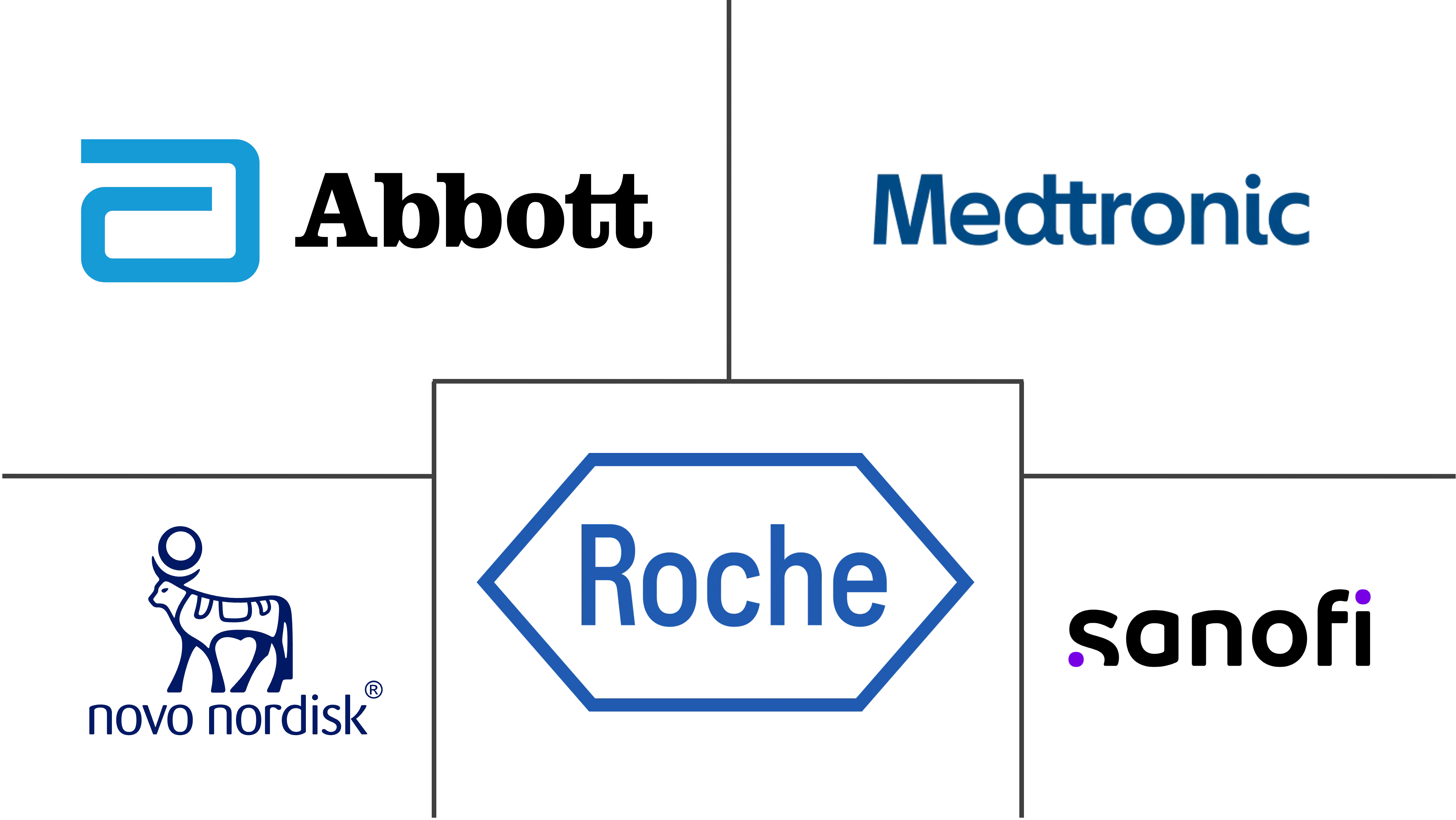United States Diabetes Care Drugs And Devices Market Size and Share
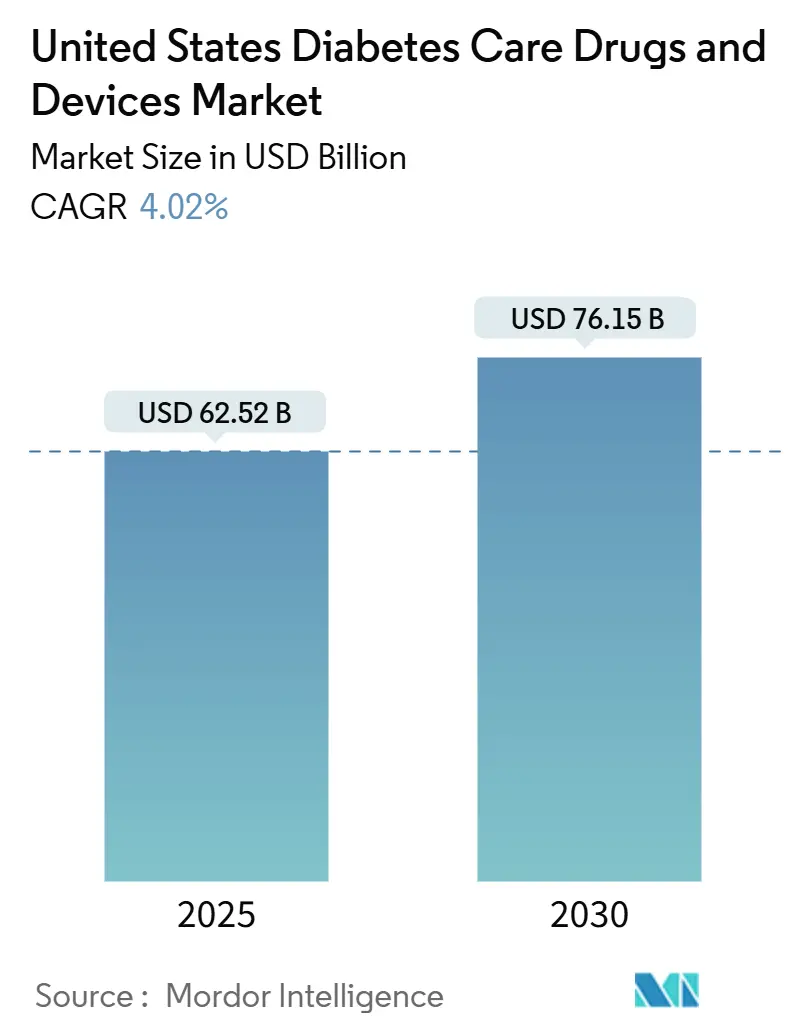
United States Diabetes Care Drugs And Devices Market Analysis by Mordor Intelligence
The United States diabetes care drugs and devices market stood at USD 62.52 billion in 2025 and is forecast to reach USD 76.15 billion by 2030, registering a 4.02% CAGR. Growth is steady rather than spectacular because headline figures mask deep structural change. Blockbuster GLP-1 receptor agonists are up-ending therapy mix, while consumer-grade continuous glucose monitors (CGMs) redraw device adoption curves. Medicare’s USD 35 insulin cap, wider CGM reimbursement, and the Food and Drug Administration’s (FDA) approval of over-the-counter (OTC) CGMs collectively lower access barriers, accelerating penetration among Type 2 diabetes patients who previously relied on finger-stick testing. At the same time, vertical integration among retail pharmacy benefit managers (PBMs) steers formularies toward preferred biosimilar insulins, compressing incumbent gross margins but freeing household budgets for advanced devices. Competitive intensity is rising as patent cliffs trigger pricing wars and supply constraints for GLP-1s open share opportunities. Privacy concerns over real-time glucose data monetization and stricter FDA oversight of closed-loop algorithms temper the outlook but do not derail the pivot toward predictive, automated management tools that blend sensors, dosing hardware, and software analytics.
Key Report Takeaways
- By product type, devices captured 34.75% revenue in 2024 while drugs dominated with 65.25%; devices are projected to expand at a 4.89% CAGR through 2030, the fastest among all categories.
- By diabetes type, Type 1 diabetes accounted for 9.57% of patients yet led innovation with a 4.65% CAGR, whereas Type 2 retained 90.43% volume but expanded more modestly.
- By age group, the geriatric cohort drove 4.78% growth owing to Medicare coverage, while adults maintained 62.23% revenue share in 2024.
- By distribution channel, online platforms held 24.55% revenue in 2024 and are advancing at 4.99% CAGR as direct-to-consumer models take hold.
United States Diabetes Care Drugs And Devices Market Trends and Insights
Drivers Impact Analysis
| Driver | (~) % Impact on CAGR Forecast | Geographic Relevance | Impact Timeline |
|---|---|---|---|
| Blockbuster GLP-1 approvals & formulary uptake | +1.2% | National, strongest in Medicare Advantage plans | Medium term (2-4 years) |
| Shift to consumer-grade CGMs | +0.8% | National, early adoption in urban markets | Short term (≤ 2 years) |
| Medicare expansion for insulin cap & CGM reimbursement | +0.6% | National, marked benefit in rural areas | Medium term (2-4 years) |
| Retail pharmacy PBM vertical integration & preferred-drug steering | +0.4% | National, varies by PBM dominance | Long term (≥ 4 years) |
| Patent cliff for basal insulins | +0.3% | National, rapid uptake in cost-focused systems | Short term (≤ 2 years) |
| AI-driven closed-loop smart pens & phone ecosystems | +0.5% | National, early wins in tech hubs | Long term (≥ 4 years) |
| Source: Mordor Intelligence | |||
Blockbuster GLP-1 Approvals & Formulary Uptake
GLP-1 receptor agonists such as tirzepatide are reshaping metabolic disease treatment by curbing progression from pre-diabetes and driving durable weight loss. Medicare Part D and major PBM formularies now prioritize these agents despite higher list prices because real-world studies show lower total cost of care via reduced complications. Integration with CGM data is improving adherence, while oral and once-weekly formulations in late-stage trials promise further convenience. The ripple effect is declining reliance on multiple daily injections and oral anti-diabetic agents, redirecting manufacturer R&D budgets toward combination therapies and precision dosing platforms.
Shift to Consumer-Grade CGMs
FDA authorization for OTC CGMs from Abbott and Dexcom eliminates prescription hurdles, expanding the addressable pool from 6 million insulin users to more than 25 million Type 2 diabetes patients who do not require insulin [1]FDA, "FDA Clears First Over-the-Counter Continuous Glucose Monitor," fda.gov. Simpler insertion, smartphone interfaces, and wellness positioning are catalyzing uptake among health-conscious consumers tracking metabolic health. Medicaid evidence reviews supporting cost-effectiveness strengthen payer confidence, and longer-wear sensors reduce per-patient supply costs [2]Washington State Health Care Authority, “Continuous Glucose Monitoring Cost-Effectiveness Review,” hca.wa.gov . Device makers are leveraging subscription models and lifestyle apps to sustain engagement.
Medicare Expansion for Insulin Cap & CGM Reimbursement
The USD 35 monthly cap on insulin under Medicare Parts B and D yields immediate savings for 3.3 million beneficiaries and sets a de facto benchmark for commercial insurers. Reclassifying CGMs as durable medical equipment simplifies coverage and removes prior authorization delays. Together, these policies elevate uptake among older adults and rural populations historically constrained by out-of-pocket costs. Commercial plans often mirror Medicare policy, amplifying nationwide impact.
Retail Pharmacy PBM Vertical Integration & Preferred-Drug Steering
Four integrated PBMs control 70% of national prescription volume, allowing them to favor high-rebate products and biosimilars that maximize spread pricing. Biosimilar insulin adoption is accelerating in cost-sensitive health systems, but formulary exclusions of certain branded GLP-1s and older DPP-4 inhibitors shift market share overnight. Legislative scrutiny and an ongoing Federal Trade Commission investigation could modify rebate contracting rules, potentially altering near-term pricing power.
Restraints Impact Analysis
| Restraint | (~) % Impact on CAGR Forecast | Geographic Relevance | Impact Timeline |
|---|---|---|---|
| GLP-1–driven fall-off in daily glucose testing | -0.7% | National, largest in Type 2 cohort | Medium term (2-4 years) |
| FDA safety overhang on once-weekly insulin icodec | -0.3% | National, affects innovation funding | Short term (≤ 2 years) |
| Persistent OOP costs for next-gen pumps | -0.4% | National, varies by employer plans | Long term (≥ 4 years) |
| Privacy push-back on real-time glucose data | -0.2% | National, stronger in privacy-aware groups | Medium term (2-4 years) |
| Source: Mordor Intelligence | |||
GLP-1–Driven Fall-off in Daily Glucose Testing Frequency
As GLP-1 therapies stabilize glycemia, many Type 2 diabetes patients reduce finger-stick testing, eroding sales of test strips and lancets. Insulin pump initiation can also be deferred when HbA1c targets are met through weight loss and improved insulin sensitivity. Manufacturers are pivoting toward multi-parameter sensors and coaching platforms to offset shrinking single-use supply volumes.
FDA Safety Overhang on Once-Weekly Insulin Icodec for T1D
The FDA rejected Novo Nordisk’s once-weekly insulin icodec for Type 1 diabetes over hypoglycemia and manufacturing issues. Advisory committee caution extends to rival programs, raising bar for long-acting formulations. Developers may need additional trials and manufacturing validation, delaying potential market entry and sustaining dependence on daily basal analogues.
Segment Analysis
By Product Type: Devices Drive Innovation Despite Drug Dominance
Drugs held a market share of 65.25% in the United States diabetes care drugs and devices market. Devices contributed USD 21.7 billion in 2025 and are forecast to grow at 4.89% annually, well above the broader United States diabetes care drugs and devices market. Continuous monitoring platforms account for most incremental revenue as OTC CGMs permeate the Type 2 population and sensor wear time extends to 15 days. Automated delivery systems such as Tandem’s t:slim X2 and Insulet’s Omnipod 5 gain regulatory clearance for Type 2 diabetes, doubling their eligible pool. In contrast, the drug category expands slowly because biosimilar basal insulins compress prices even as GLP-1s climb the formulary.
Sensor-linked pumps enable algorithmic micro-bolusing and attract premium reimbursement. Abbott’s Libre Rio addresses clinical users while its Lingo targets wellness, illustrating a bifurcated go-to-market strategy that maximizes both prescription and retail channels. CGM makers increasingly bundle data analytics, subscription coaching, and lifestyle content to mitigate margin pressure on hardware. Across therapy classes, ecosystem lock-in—rather than standalone hardware—drives competitive advantage in the United States diabetes care drugs and devices market [3]Medtronic, “MiniMed 780G Integrated with Simplera Sync Sensor,” medtronic.com .
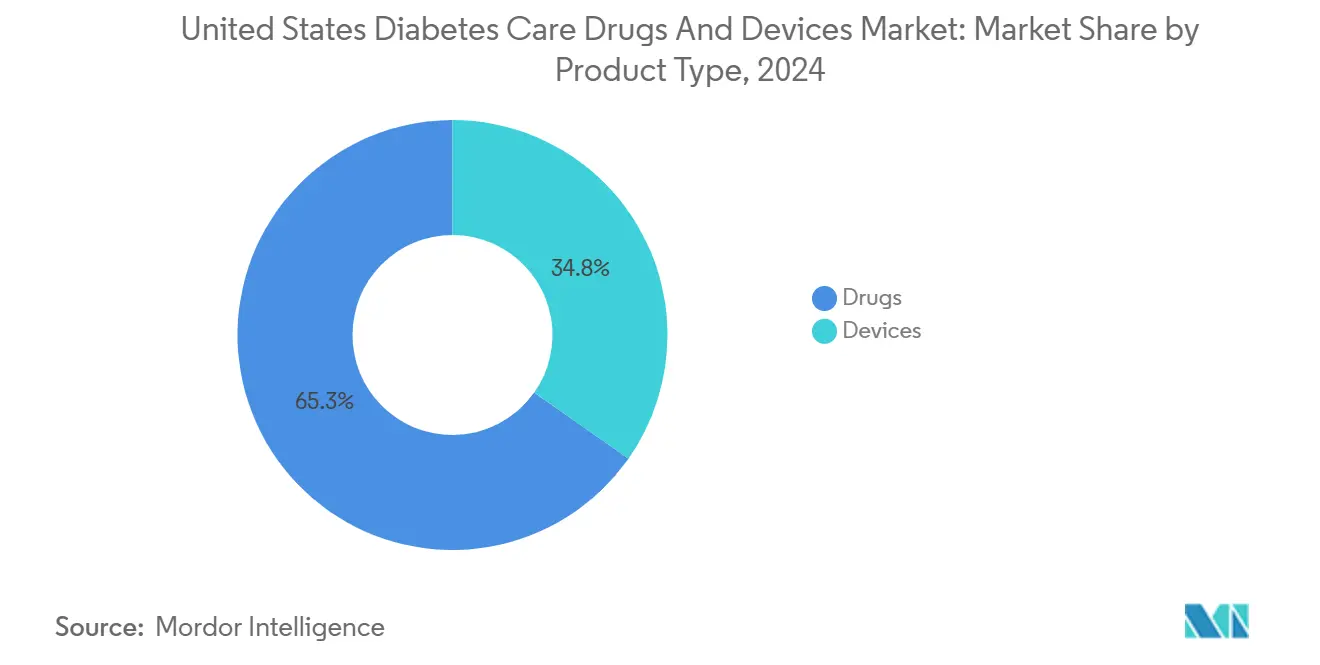
Note: Segment shares of all individual segments available upon report purchase
By Diabetes Type: Type 1 Innovation Leads Market Evolution
Type 1 diabetes generated USD 6 billion in 2025 and is advancing at 4.65% CAGR through 2030, outpacing the overall United States diabetes care drugs and devices market. High technology acceptance, willingness to pay, and the clinical necessity of tight glucose control underpin device penetration exceeding 75%. Tandem’s Control-IQ+ algorithm and Medtronic’s MiniMed 780G now extend closed-loop automation to younger age groups, further elevating Type 1 adoption curves.
Type 2 diabetes held 90.43% market share in 2024 and commands the bulk of revenue but faces decelerating volume growth due to aggressive prevention campaigns and evidence that tirzepatide cuts diabetes onset by 94%. Nonetheless, opportunity remains in early-stage Type 2 patients seeking metabolic insight; OTC CGMs and weight-management GLP-1s meet that demand. Device firms pilot lower-cost pump subscription models for insulin-requiring Type 2 patients, potentially lifting future United States diabetes care drugs and devices market size for this segment.
By Age Group: Geriatric Surge Drives Technology Adoption
The geriatric segment will expand at 4.78% CAGR. Medicare’s insulin cap, durable medical equipment designation for CGMs, and the FDA’s Health Care at Home initiative remove historic barriers to tech adoption. Simplified user interfaces, voice prompts, and auto-insert sensors suit cognitive and dexterity limitations common in older adults.
The adult cohort (18–64 years) remains the largest contributor to the United States diabetes care drugs and devices market size, holding 62.23% market share in 2024, sustained by employer insurance coverage and early uptake of wellness-focused CGMs. Pediatric growth is smaller numerically but strategically important; devices engineered for family oversight often inform broader platform design, enhancing overall ecosystem competitiveness.
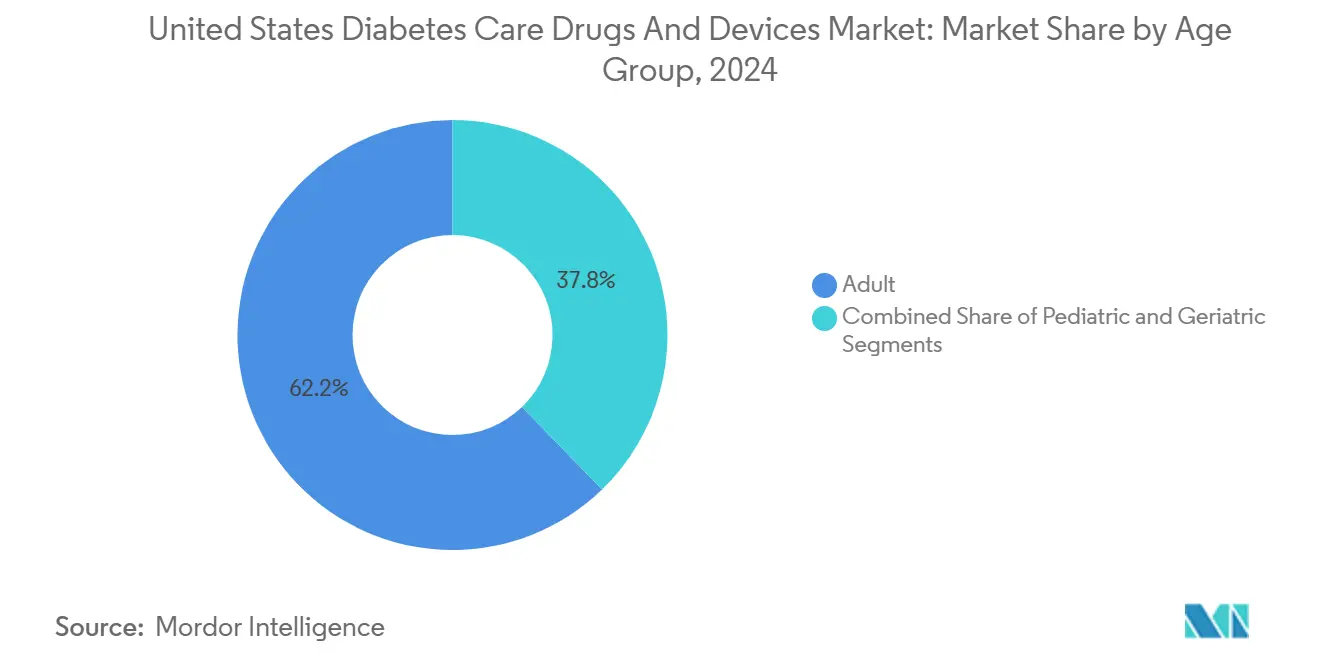
Note: Segment shares of all individual segments available upon report purchase
By Distribution Channel: Digital Transformation Accelerates
Offline pharmacy and hospital channels still controlled 75.45% of 2024 revenue, yet online sales grew 4.99% annually and will surpass USD 20 billion by 2030. Direct-to-consumer storefronts for CGMs and smart pens reduce reliance on PBMs, while tele-prescribing services improve regional access. Manufacturers bundle sensors with virtual coaching subscriptions that ship supplies automatically, raising retention.
PBM formulary steering motivates device makers to court self-pay consumers through e-commerce, a tactic evident in Dexcom’s Stelo launch. Hybrid fulfillment models—online ordering with in-store pickup—help pharmacies retain foot traffic. Channel diversification decreases rebate leakage and expands margin capture across the United States diabetes care drugs and devices market.
Geography Analysis
Regional adoption patterns reflect income, payer mix, and infrastructure gaps. Medicare-led insulin and CGM reforms most profoundly affect the South and Midwest, where diabetes prevalence and lower incomes magnify out-of-pocket sensitivity. Rural clinics leverage remote monitoring to overcome specialist shortages, aligning with the FDA’s home-based care pilots.
Urban centers on the coasts adopt OTC CGMs fastest due to tech literacy and wellness trends. Employer self-insured plans in these regions frequently reimburse GLP-1s for obesity management, boosting early volume. Conversely, PBM concentration in certain states dictates formulary variation; single-PBM dominance can limit GLP-1 access yet encourage biosimilar insulin use.
State policy activism also shapes geography. California’s plan to manufacture low-cost insulin could upend pricing once capacity comes online. Meanwhile, Medicaid expansions in Washington and Colorado widen CGM eligibility, fostering device penetration beyond Medicare. Health-system consolidation in the Northeast supports bulk procurement of integrated device-drug ecosystems, advancing closed-loop adoption. Together, these regional vectors drive a patchwork growth profile inside the United States diabetes care drugs and devices market.
Competitive Landscape
Abbott and Dexcom dominate sensing; Medtronic, Tandem, and Insulet lead pumps; Novo Nordisk and Eli Lilly command injectable therapies. Co-development deals such as Abbott’s integration with Tandem pumps illustrate convergence, as firms seek end-to-end solutions.
Patent cliffs for Lantus and other basal insulins unleash biosimilar entrants like Viatris, intensifying price wars. GLP-1 demand outstrips supply, prompting manufacturers to invest in capacity while competitors aim for next-generation dual-agonists. Device companies face FDA scrutiny of manufacturing controls, evidenced by Dexcom’s 2025 warning letter that forced corrective actions.
Non-traditional players—digital health start-ups and big-tech partners—deploy AI algorithms predicting glucose excursions an hour in advance, offering subscription dashboards. Interoperability guidelines allow smaller sensor or algorithm firms to plug into established pump ecosystems, lowering barriers. Privacy regulation remains a wild card; strict consent rules could crimp data-monetization strategies that subsidize hardware costs across the United States diabetes care drugs and devices market.
United States Diabetes Care Drugs And Devices Industry Leaders
-
Medtronics
-
Roche
-
NovoNordisk
-
Sanofi
-
Abbott Laboratories
- *Disclaimer: Major Players sorted in no particular order
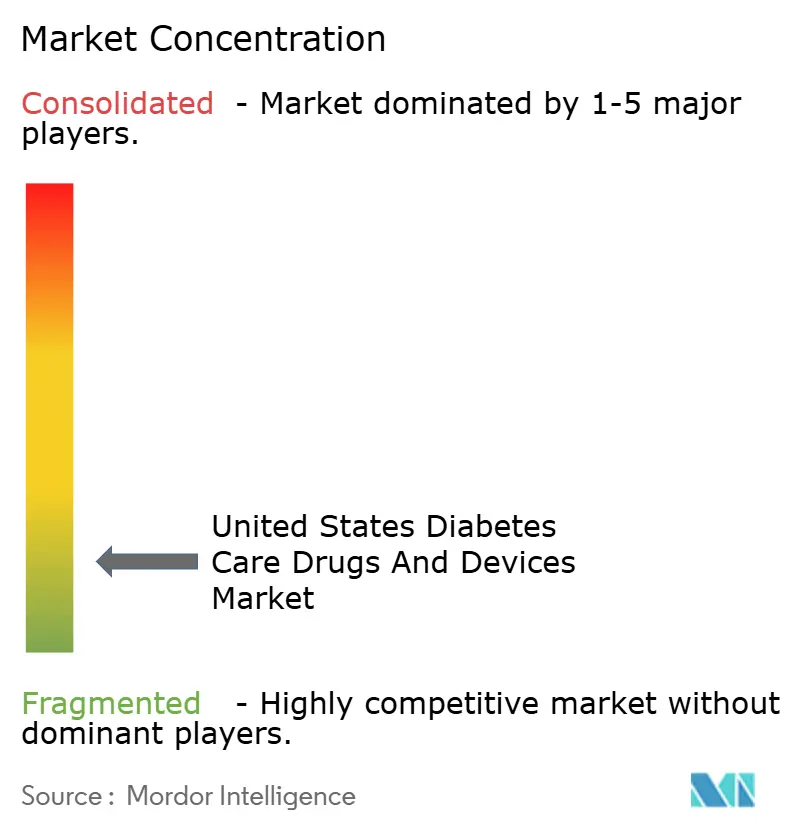
Recent Industry Developments
- June 2025: Tandem Diabetes Care announced t:slim X2 pump compatibility with Abbott FreeStyle Libre 3 Plus 15-day sensor, targeting commercial release in H2 2025.
- April 2025: Medtronic gained FDA clearance for Simplera Sync sensor integration with MiniMed 780G, eliminating finger-stick calibration.
- March 2025: FDA issued warning letter to Dexcom citing G6 and G7 process-control deficiencies, requiring remediation to avoid sanctions.
- February 2025: Tandem secured FDA clearance for Control-IQ+ algorithm in Type 2 diabetes, expanding its addressable base by more than 2 million users.
Research Methodology Framework and Report Scope
Market Definitions and Key Coverage
Our study defines the United States diabetes care drugs and devices market as every prescription or over-the-counter medicine formulated to manage blood glucose (insulins, non-insulin injectables, and oral anti-diabetics) together with monitoring and delivery hardware sold new within U.S. borders, including sensors, test strips, meters, continuous glucose monitors, insulin pumps, pens, syringes, and associated disposables. This combined view mirrors how patients fund and clinicians prescribe integrated therapy pathways; therefore, Mordor Intelligence models drugs and devices inside one revenue pool.
Scope exclusion: services such as diabetes coaching apps, laboratory HbA1c testing, and bariatric procedures sit outside this market.
Segmentation Overview
- By Product Type
- Devices
- Monitoring Devices
- Self-Monitoring Blood Glucose Meters
- Continuous Glucose Monitoring Systems
- Management Devices
- Monitoring Devices
- Drugs
- Oral Anti-Diabetic Drugs
- Insulin Drugs
- Non-Insulin Injectables
- Combination Drugs
- Devices
- By Diabetes Type
- Type 1 Diabetes
- Type 2 Diabetes
- By Age Group
- Adult
- Geriatric
- Pediatric
- By Distribution Channel
- Offline
- Online
Detailed Research Methodology and Data Validation
Primary Research
Mordor analysts interviewed endocrinologists, diabetes educators, state-level payers, and supply-chain distributors spanning the Northeast, Midwest, South, and West. These conversations validated real-world device utilization, refill cadence, and likely price erosion, while short online surveys of patients and pharmacists clarified channel mix shifts toward e-commerce.
Desk Research
We first mined authoritative public datasets such as CDC Diabetes Surveillance, CMS Medicare Part D pricing files, FDA 510(k) device clearances, and U.S. International Trade Commission shipment codes to capture prevalence, reimbursement ceilings, and import volumes. Trade associations, for instance, the Advanced Medical Technology Association and the Pharmaceutical Research and Manufacturers of America, supplied guideline updates and channel dynamics. Company 10-Ks and investor decks revealed segment sales and average selling prices that we cross-checked inside D&B Hoovers and Dow Jones Factiva for consistency. Several peer-reviewed journals helped us benchmark adoption rates for continuous glucose monitoring and GLP-1 therapies. This list is illustrative; many additional sources informed our desk work.
Market-Sizing & Forecasting
A top-down model begins with the diagnosed and estimated undiagnosed diabetic population, multiplies by therapy penetration and device ownership rates, and is indexed to insurance coverage limits. Supplier roll-ups of leading pump and pen shipments provide bottom-up checkpoints. Variables tracked include obesity incidence, Medicare insulin co-pay caps, CGM reimbursement expansions, retail insulin analog ASP trends, and state telehealth uptake; each feeds a multivariate regression that projects unit demand through 2030. Where distributor volumes were partial, we filled gaps by applying average per-patient strip and sensor consumption derived from primary research.
Data Validation & Update Cycle
Outputs flow through three-layer analyst review; anomaly flags trigger re-checks with respondents, and variance above two percentage points versus historical series prompts model recalibration. Reports refresh yearly, and an interim update releases whenever policy or recall events materially shift assumptions.
Why Mordor's US Diabetes Drugs and Devices Baseline Commands Reliability
Published estimates often vary because firms slice the market differently, choose unique price assumptions, or refresh at alternate cadences. Decision makers therefore meet a confusing spread of numbers.
Key gap drivers stem from whether devices and drugs are combined, how over-the-counter sensors are counted, if wholesaler discounts or retail margins are used, and how frequently models absorb Medicare policy shifts. Mordor Intelligence aligns scope with patient spend, refreshes annually, and subjects every assumption to on-ground expert validation, which limits drift.
Benchmark comparison
| Market Size | Anonymized source | Primary gap driver |
|---|---|---|
| USD 62.52 B (2025) | Mordor Intelligence | - |
| USD 54.84 B (2024) | Global Consultancy A | Excludes consumer CGM sensors and uses list prices only |
| USD 48.00 B (2024) | Industry Association B | Focuses on retail channels, omits hospital pump sales and limited primary checks |
The comparison shows how narrower scopes or single-source pricing pull other estimates below ours, while Mordor's disciplined mix of public data, paid intelligence, and field insight yields a balanced, transparent baseline that stakeholders can trace and reproduce.
Key Questions Answered in the Report
What is the current value of the United States diabetes care drugs and devices market?
The market reached USD 62.52 billion in 2025 and is projected to climb to USD 76.15 billion by 2030.
Which segment is growing fastest within the market?
Devices, notably continuous glucose monitoring and automated insulin delivery, are expanding at a 4.89% CAGR through 2030.
How are Medicare policies affecting market growth?
The USD 35 insulin cap and broader CGM reimbursement under Medicare lower patient costs and widen technology access, adding 0.6 percentage points to forecast CAGR.
Why are GLP-1 receptor agonists considered disruptive?
They not only lower HbA1c but also delay or prevent Type 2 diabetes onset; strong clinical outcomes have shifted PBM formularies toward these drugs despite premium prices.
What regulatory hurdles are manufacturers facing?
The FDA is increasing scrutiny of extended-release insulin safety and device manufacturing quality, as illustrated by the rejection of weekly insulin icodec and Dexcom’s 2025 warning letter.
How concentrated is the competitive landscape?
Seven leading firms hold 56% share, reflecting moderate concentration; ecosystem partnerships and biosimilar entry keep competitive pressure high.
Page last updated on:
